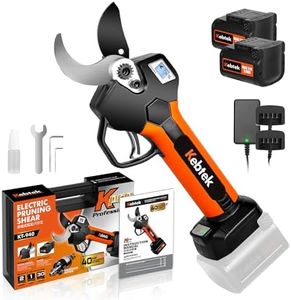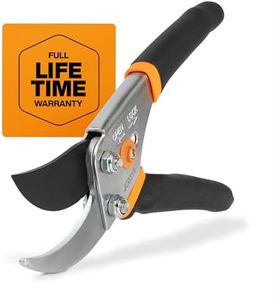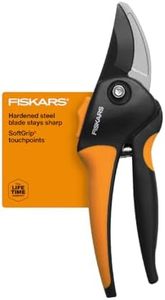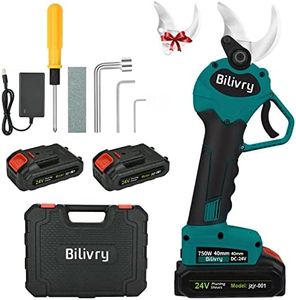We Use CookiesWe use cookies to enhance the security, performance,
functionality and for analytical and promotional activities. By continuing to browse this site you
are agreeing to our privacy policy
10 Best Pruning Shears
From leading brands and best sellers available on the web.Buying Guide for the Best Pruning Shears
Choosing the right pruning shears can make gardening tasks much easier and help keep your plants healthy. Pruning shears, also known as hand pruners or secateurs, are essential tools for trimming, shaping, and removing dead or overgrown stems and branches from plants. The right pair will feel comfortable in your hand, cut smoothly, and be durable enough for repeated use. When picking pruning shears, it’s important to consider their cutting mechanism, blade type, handle ergonomics, and a few other key features to match your gardening needs and physical comfort.Cutting Mechanism (Bypass vs. Anvil)Pruning shears generally come in two main types based on their cutting action: bypass and anvil. Bypass shears have two blades that pass by each other like scissors, making clean cuts ideal for live, green branches. Anvil shears have one straight blade that cuts down onto a flat edge (the anvil), which can be better for dry, dead wood. If you frequently cut green, living stems and want smooth cuts that help plants heal faster, bypass shears are usually the best choice. If you’ll be tackling mainly thick, dead branches, anvil shears can provide the extra force needed. Think about the kinds of plants and branches you deal with most to guide your decision.
Blade Quality and MaterialThe material and sharpness of the blades affect both cut quality and durability. Blades are often made of stainless steel or high-carbon steel. Stainless steel resists rust and is easy to maintain, which is good for those working in damp environments or who want less maintenance. High-carbon steel stays sharper longer and makes cleaner cuts but can rust if not cared for. Consider how often you want to sharpen your shears and whether you’re likely to leave them out in the weather when choosing blade material.
Cutting CapacityCutting capacity refers to the maximum thickness of stem or branch the shears can handle, often measured in millimeters or inches. Lighter-duty pruners can snip twigs and stems up to about 1/2 inch, while heavy-duty garden pruners tackle branches up to 1 inch or more. Think about the types of plants and average branch size in your garden. If you have roses and small shrubs, a lower cutting capacity is sufficient. If you have fruit trees or thick, woody bushes, you’ll want a higher cutting capacity.
Handle Design and ErgonomicsThe comfort and design of the handles are crucial, especially if you’ll be pruning for long periods. Handles may have rubberized grips, contoured shapes, or even rotating designs to reduce hand fatigue. Smaller hands may need compact or slim handles, while larger hands might prefer longer handles. If you have arthritis or hand pain, look for ergonomic or ratcheting handles that require less force to cut. Always consider how the tool feels in your hand, not just its appearance.
Locking Mechanism and Safety FeaturesMost pruning shears come with a locking mechanism to keep the blades closed when not in use, preventing accidental cuts. Some locks can be operated with one hand, which is convenient if you’re multitasking. A reliable lock that stays in place increases safety, especially if children are around or the shears are carried in a pocket. Test out the lock if possible, and go for a design you can easily operate but won’t accidentally unlock.
Maintenance and Replaceable PartsOver time, even the best pruning shears need cleaning, sharpening, or occasionally new parts. Some models allow you to replace blades, springs, or other components, which can extend the life of your tool significantly. If you prefer a long-lasting tool and don’t mind a little upkeep, pick shears with parts that are easy to replace and widely available. If you want as little maintenance as possible, look for shears marketed as low-maintenance or rust-resistant.
















